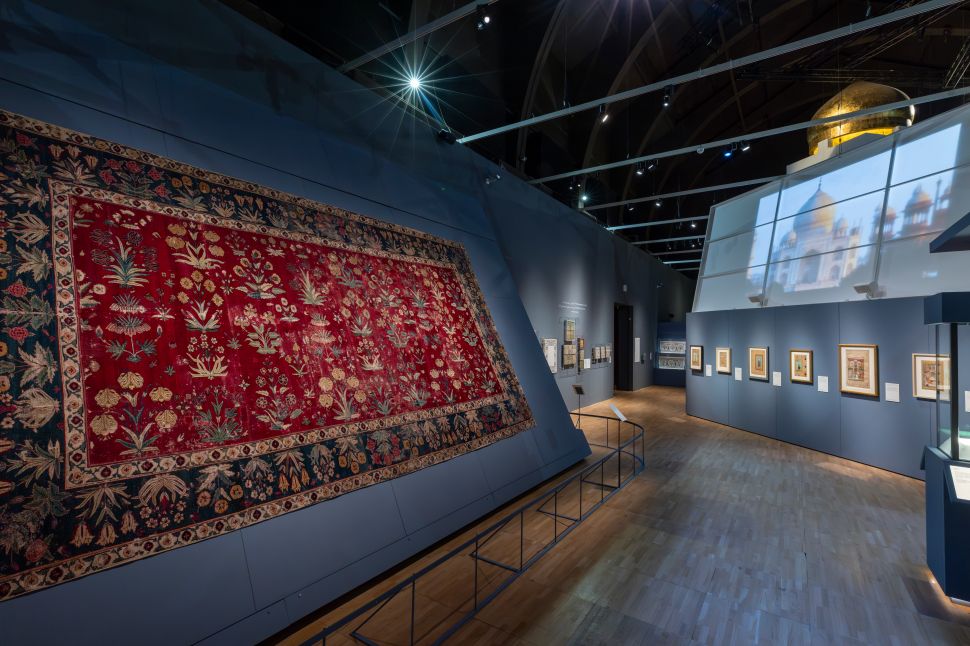When the Mughal empress Mumtaz Mahal died in 1631, her husband Shah Jahan built a mausoleum in her memory. The Great Mughals didn’t do things by halves, and Mumtaz Mahal’s final resting place, the Taj Mahal (building cost at the time: 32 million rupees, or $750 million, in today’s money) in Agra, India, remains a touchstone of architectural elegance. Shah Jahan, his father Jahangir and his grandfather Akbar were the Great Mughals, the early emperors of the mighty Mughal dynasty that sprawled across the Indian subcontinent (that then included Pakistan, Nepal, Afghanistan and Bangladesh) and ruled from 1526 until 1858. The emperors’ elevation from mere garden variety Mughals to greatness comes from their patronage of beautiful things, and the Victoria and Albert Museum in London’s “The Great Mughals: Art, Architecture and Opulence” exhibition applauds the trio’s creative and cultural achievements.
The V&A is the ideal backdrop for the show. Built as another royal tribute—to Queen Victoria and her husband, Prince Albert—just before the Mughals’ dynastic period collapsed, the museum is a graceful, imposing jewel in London’s institutional arts crown. Inside, the exhibition’s curators have gone to town, assembling a dizzying array of objects and artwork commissioned by the emperors to tell the story of the dynasty.
Arranged over three sections, “The Great Mughals” covers the eras of Akbar (who reigned from 1556 until 1605), Jahangir (1605-1627) and Shah Jahan (1627-1666). Akbar ascended the throne aged just thirteen and a Mughal military commander, Bairam Khan, ruled on his behalf until Akbar was deemed old enough to take charge of the empire. Akbar’s achievements were many and notable. Under his ruling tenure, religious tolerance became the norm, he introduced administrative structures that lasted long into the future and his appreciation for the arts permeated across his domain. Artifacts on display include volumes of the Hamzanama (Book of Hamza), commissioned by Akbar in the 1570s. Folkloric tales and battle stories are depicted within: an illustration of the mythical giant Zumurrud Shah vanquishing his foes teems with action. Walls are hung with serried ranks of contemporaneous paintings. A suitably regal representation of Akbar handing the imperial crown to Shah Jahan is bordered with decorous gold leaf. A two-meter-long carpet–on view in the U.K. for the first time–almost takes up an entire wall across the room and shows the myth of the gajasimha (a winged beast with the body of a lion and an elephant’s head) under attack from the phoenix-like simurgh. It’s stunning.
The objects selected for Jahangir’s turn include his jade-hilted dagger, its scabbard set with rubies, emeralds and a pearl, a jade wine cup inscribed with Jahangir’s titles and Persian verses in praise of wine and a Mughal hunting coat. The coat is exquisitely embroidered with prey—tigers, leopards, deer and hares—and curling foliage across panels of white silk. Jahangir took artists with him as his court traveled across the empire, and there’s a space dedicated to their pictorial documentations, including a delicate painting of a zebra made by famed Mughal court artist Ustad Mansur. Other paintings convey the dynasty’s cosmopolitan edge. The portrait of a visiting European, possibly a Portuguese ambassador passing through to pay his respects, is brimming with color and depth.
The Shah Jahan section begins with a video of the Taj Mahal. Beneath is one of the original marble maquettes for Mumtaz Mahal’s cenotaph with tenderly rendered watercolor designs for the tomb’s ornamental inlays alongside. Precious gems are posed on pins in a case nearby. A carved ruby the size of a quail’s egg stands next to cut diamonds, all of which were once part of the emperor’s jeweled throne. In the case next door are four beads, two made from emeralds and one each carved from a sapphire and an aquamarine. Being so close to such dazzling stones feels quietly thrilling. The perusing visitors’ gentle, hushed gasps at the exhibits mingle with the show’s sounds piped in from above. Hypnotic sitars hazily drone and twang. Birds warble, and there’s the occasional thunk of hammers hitting metal and stone, recreating the ambiance of the Mughals’ artisanal workshops and palace gardens.
“Great Mughals” is an exhibition that unashamedly celebrates excess as well as accomplishments. As for how the emperors gained their riches, some historians suggest it was through prurient economic policies and the aforementioned open-hearted approach to matters of faith. Others argue the emperors were warmongering empire builders who subjugated their people. Certainly, not everything was hearts and flowers in the Great Mughals’ universe. Mumtaz Mahal bled to death after giving birth to her fourteenth child, and her husband spent his last eight years in prison on the orders of his third son, Aurangzeb. Shah Jahan appointed another son, Dara Shikoh, as his successor, and Aurangazeb slaughtered Dara Shikoh, along with his other brothers, to claim the throne. By 1858, the Mughal Dynasty died out, having succumbed, in part, to the U.K.’s state-sponsored colonization of the Indian subcontinent under the guise of the British East India Company.
Explanations of just how the Mughals became so wealthy and all-conquering are sidestepped here. Rather, text by the exhibition’s exit proudly reminds departing visitors that the word Mughal is a derivation of Mogul (Genghis Khan was a distant cousin of the Great Mughals)—and a 21st-century mogul is someone who has achieved power and success. Perhaps that’s the point: raking over the emperors’ politics can happen somewhere else. In the meantime, “The Great Mughals” offers the chance to leave all the bad stuff in the cold outside and immerse oneself in a dreamy collection of some of the most opulent and indulgent pieces in world history.
“The Great Mughals: Art, Architecture and Opulence” is at the V&A in South Kensington, London through May 5, 2025. Advanced booking is advised.

